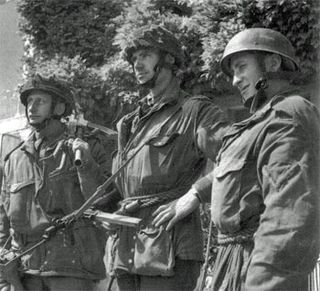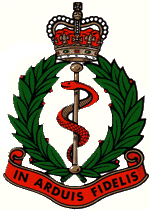Related Research Articles

John Daniel Baskeyfield was a British Army soldier an English recipient of the Victoria Cross (VC), the highest award for gallantry in the face of the enemy that can be awarded to members of the British and Commonwealth armed forces.

The Indian Army during World War II, a British force also referred to as the British Indian Army, began the war, in 1939, numbering just under 200,000 men. By the end of the war, it had become the largest volunteer army in history, rising to over 2.5 million men in August 1945. Serving in divisions of infantry, armour and a fledgling airborne force, they fought on three continents in Africa, Europe and Asia.

Colonel Justice Marion Chambers was a United States Marine Corps officer who received the Medal of Honor for actions in World War II during the Iwo Jima campaign.

Major General James Lewis Day was a United States Marine Corps major general who served in World War II, in the Korean War, and in the Vietnam War. He was awarded the Medal of Honor for his heroic actions as a corporal on May 14 to 17, 1945 during the Battle of Okinawa in World War II.

The 5th Parachute Brigade was an airborne forces formation of brigade strength, raised by the British Army during the Second World War. Created during 1943, the brigade was assigned to the 6th Airborne Division, serving alongside the 3rd Parachute Brigade and the 6th Airlanding Brigade.

The 1st Parachute Brigade was an airborne forces brigade formed by the British Army during the Second World War. As its name indicates, the unit was the first parachute infantry brigade formation in the British Army.

The 4th Parachute Brigade was an airborne, specifically a parachute infantry, brigade formation of the British Army during the Second World War. Formed in late 1942 in the Mediterranean and Middle East, the brigade was composed of three parachute infantry units, the 10th, 11th and 156th Parachute Battalions.

The 1st Airlanding Brigade was an airborne infantry brigade of the British Army during the Second World War and the only glider infantry formation assigned to the 1st Airborne Division, serving alongside the 1st Parachute Brigade and 4th Parachute Brigade.
Alexander Percival Johnson DSO, known as Johnny Johnson, was a British Army officer.

The 6th Airlanding Brigade was an airborne infantry brigade of the British Army during the Second World War. Created during May 1943, the brigade was composed of three glider infantry battalions and supporting units, and was assigned to the 6th Airborne Division, alongside the 3rd and 5th Parachute Brigades.
12 (Vancouver) Field Ambulance is a Canadian Forces Primary Reserve medical unit in Vancouver, British Columbia.

Major Robert Henry Cain VC TD was a Manx recipient of the Victoria Cross, the highest award for gallantry in the face of the enemy that can be awarded to British and Commonwealth forces.
Colonel John Llewellyn Waddy OBE was a British Army officer who served during the Second World War, Palestine and the Malayan Emergency before becoming Colonel of the SAS.

The 16th (Parachute) Field Ambulance was a Royal Army Medical Corps unit of the British airborne forces during the Second World War. The unit was the first parachute field ambulance unit of the British Army. Their first deployment was in Operation Torch the Allied landings in North Africa. This was followed by Operation Fustian during the Allied invasion of Sicily. Their third mission was Operation Slapstick, a seaborne landing at Taranto in Italy.

The 181st (Airlanding) Field Ambulance was a Royal Army Medical Corps unit of the British airborne forces during the Second World War.

The 225th (Parachute) Field Ambulance was a Royal Army Medical Corps unit of the British airborne forces during the Second World War.

The 195th (Airlanding) Field Ambulance was a Royal Army Medical Corps unit of the British airborne forces during the Second World War.

The 133rd (Parachute) Field Ambulance was a Royal Army Medical Corps unit of the British airborne forces during the Second World War.

The 224th (Parachute) Field Ambulance was a Royal Army Medical Corps unit of the British airborne forces during the Second World War.

Rathvon McClure Tompkins was a highly decorated United States Marine Corps major general. He saw combat in World War II, the Korean War, the Vietnam War and led Marine units during the Dominican Civil War. Tompkins is well known for his part as commander of the 3rd Marine Division during the Battle of Khe Sanh in Vietnam.